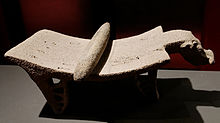Metate

A metate (Spanish el metate , from náhuatl métlatl ) is a grinding stone that was used by all Central American cultures well into the 20th century. It consists of a flat, usually three-legged bowl or friction surface and the mano or a cylindrical pestle . The friction surface was made of hard volcanic rock or softer limestone, depending on the area ; the rubbing stones consisted mainly of volcanic rock, which z. B. had to be imported from afar on the Yucatán peninsula .
With the help of the metates - with the constant addition of a few drops of water - corn was ground by hand, which was then immediately prepared into tortilla dough (Spanish la masa ). Separate metates were used to make cocoa (náhuatl xocolatl ) or the ingredients for moles .
There were also small metates specially made for sacrificial purposes , which shows the close connection between the Mesoamerican religions and cultures to the staple food 'corn'.
Since the middle of the 20th century, the rubbing stones have been replaced by electrically operated mills, which can be found in every village today and relieve women of a tedious job. On the other hand, a little lime is often added to the dough today, which in the past was created by itself through the natural abrasion of the friction surfaces.


